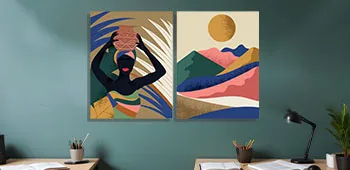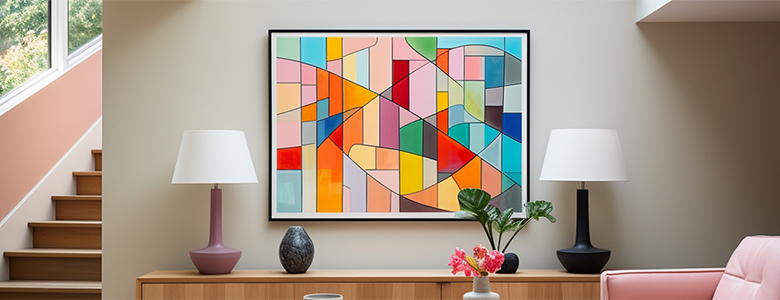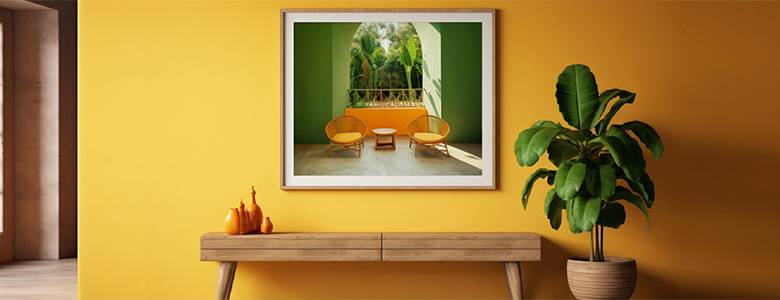

To apply design for the remaining sides of the product, please click on “Upload design” link.
Yes, it's that easy!
Happy decorating!

Handle with clean, dry hands, store flat in a cool, dry place, and protect from direct sunlight and humidity.
1

2

3

An art print is a reproduction of an original artwork, produced using some printing techniques. It enables more people to possess copies of the artwork.
Original artworks are unique creations made by the artist, whereas art prints are duplicates of the original, often produced in multiple copies.
Standard printing techniques for art prints include digital printing, offset printing, and giclee printing. Different techniques offer varying levels of quality and features.
Consider the wall's dimensions when choosing print size. Select a size that fits well with the room's proportions and existing décor.
Art prints can be printed on a range of materials such as paper, canvas, or metal. The choice of material impacts texture and appearance of the print.
Yes. Framing an art print can enhance its presentation. Select a frame that co-ordinates well with the art print as well as the surrounding space.
To preserve art prints, prevent exposure to direct sunlight and moisture. When framing, opt for UV-protective glass. Do not touch the print directly. Clean gently with a soft, dry cloth.
It can last more than a hundred years, if kept out of direct sunlight or under normal indoor conditions. So, be mindful of where you choose to display your artwork.
Start by measuring the width and height of your wall and then multiply each with 0.60 and 0.75, respectively, to get the range of canvas print sizes that will suit the space.
Matte, cotton rag, or canvas are the preferred choices for art prints. However Red river paper gives the best quality output.
Welcome to the world of craftsmanship! If you have ever admired an original masterpiece and want to bring a piece of its beauty into your space, you are at the right place. Whether you are an aspiring artist, a seasoned collector, or just an art enthusiast passionate about exploring secret magic, there’s a solution to everything.
We have 8 valuable tips to help you create limited-edition art prints from original works.
1. Digitizing Your Artwork
The first step is to create high quality digital versions of your original artwork. This can be done through professional scanning or photography, ensuring that the digital representation accurately captures the text, color and essence of the original product. It is best advised to stick to a higher resolution.
2. Selecting Materials and Print Methods
The choice of printing material greatly affects the look and feel of the final product. Printing techniques such as giclée must provide consistency and durability to be considered suitable for limited printing.
Earlier, the sale of art prints relied on art galleries and exhibitions; however, the evolution of e-commerce platforms has allowed many independent artists and entrepreneurs to rise and sell their art forms online and reach wider markets. E-commerce sales have broadened the potential of art consumers, thus accentuating the growth of art market.
Marketing your talent online is easy but requires an understanding of the ins and outs of e-commerce strategies for a successful online business. This blog will help you with the required tips for successfully selling art prints online through e-commerce platforms.
1. Define Your Target Audience
Before going online, conduct thorough research on what type of art forms customers prefer purchasing or what type of audience is most interested in purchasing your style of art prints.
2. Select the Right Platform
Selecting the right e-commerce platform can help you showcase your art to the relevant audience, connect with them, and build a long-lasting professional relationship.
Are you caught in the age-old dilemma of choosing between art prints and posters to adorn your walls? Distinguishing between art prints and posters can be a bit perplexing at times. They can look quite alike in some cases, but they differ in crucial aspects.
What is an Art Print?
An art print essentially refers to a reproduction of an original artwork. Reproduced on a print medium, art works are intended for display with care.
What is a Poster?
A clearer definition is that a poster is a printed message, often in photographic, illustrated, or textual form (or a blend of all three), designed to engage viewers or evoke specific emotions.


